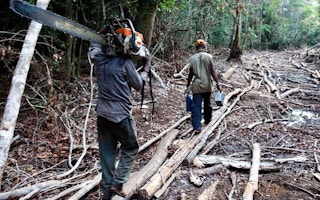Global digital security firm Gemalto and San Francisco-based non-profit group Rainforest Connection are behind two of the latest solutions to illegal logging.
To continue reading, subscribe to Eco‑Business.
There's something for everyone. We offer a range of subscription plans.
- Access our stories and receive our Insights Weekly newsletter with the free EB Member plan.
- Unlock unlimited access to our content and archive with EB Circle.
- Publish your content with EB Premium.
Conducting separate forest protection efforts, both organisations are employing new technology-driven strategies to monitor illegal land clearing in real time. This leads to critical real-time intervention unlike traditional methods of radio monitoring and satellite surveillance, which only come after the fact.
Recently, NASA satellite data has been frequently used in assessing forest fires in Indonesia, which have caused severe air pollution in Malaysia and Singapore. This information vis-à-vis concession maps from palm oil and paper and pulp companies helped determine the firms responsible for the fires. However, no firm has been categorically held liable. And at the recently concluded 15th Meeting of the Sub-Regional Ministerial Steering Committee on Transboundary Haze Pollution, the three countries, discussing forest fire prevention among other issues, noted in their closing statement that there is a “need for better early warning systems … so that immediate mitigation actions could be undertaken”.
The latest solutions from Gemalto and Rainforest Connection are capable of early detection. When an illegal logging activity is detected, signals are immediately sent to on-the-ground officials, notifying them to respond and capture perpetrators in the act of selling illegally harvested lumber or doing further deforestation.
Gemalto
In Brazil, Gemalto partnered with tech firm Cargo Tracck to stop illegal logging in the Amazon forest.
According to Greenpeace, up to 80 per cent of logging in the Amazon and Indonesia are thought to be illegal. Brazil and Indonesia are two of only ten countries in the world where deforestation occurs, declared WWF, and the two nations account for 51 per cent of carbon emissions from this forest loss.
The joint pilot programme between Gemalto and Cargo Tracck has resulted in a wireless tracking device called Invisible Tracck. The device capitalises on Gemalto’s machine-to-machine (M2M) technology, specifically the Cinterion BGS2 module, which is built in to the gadget. The Invisible Tracck, smaller than a deck of cards, passes location information from the module to a central server, via the local cellular networks. From the server, alerts are then sent to rangers and officials of the Brazilian Environment and Natural Resources Institute (IBAMA), the country’s environment protection agency.
Currently, according to Lakhi Baug, Gemalto’s solution sales manager, “The devices are installed in remote active harvesting areas deep in the jungle, with night vision cameras installed in nearby trees to capture visual evidence of illegal logging.”
Invisible Tracck, he detailed, is an inconspicuous device, camouflaged in a resin case to blend with tree trunks. It is very robust and can withstand the harsh environment conditions of the Amazon. At the same time, the module’s advanced power management system allows the device to remain active in the forest for a year without any need for recharging.
The Invisible Tracck instantly monitors the tree it is attached to. Location data is recorded using the high-speed GPRS data transmission of the Cinterion module and Radiation Data Exchange (RED) technology. Baug said, RED amps up the range of wireless communications, “to overcome the fact that the rainforest spans such a wide area.” This means when a tree is cut down, transported and comes within 32 kilometres of a cellular network, the device automatically sends an alert.
“The effectiveness of this solution in reducing the deforestation of the Amazon rainforest has been unparalleled,” said Baug, in an email to Eco-Business. “According to reports by BBC, deforestation has slowed and is now at its lowest level since monitoring began. The devices have overcome the challenges facing old tracking strategies via satellites and other traditional methods … it has also addressed the challenges posed by the humidity and density of the forest environment.”
Rainforest Connection
While there are no plans yet to replicate the Gemalto and Cargo Tracck project in other countries, Rainforest Connection from the United States has targeted Indonesia for its first forest protection initiative.
The young non-profit is similarly relying on M2M technology to thwart illegal logging, although not through the typical high-tech means. Instead, banking on ingenuity, Rainforest Connection founder Topher White plans to install used or discarded Android smartphones in the rainforests of Sumatra, which will send an alert to rangers upon recording the sounds of a chainsaw.
For its first deployment, though, fifteen new phones will be used and placed in the 25,000-hectare Air Tarusan reserve. These Android phones, to be powered by small solar panels, will be tweaked to continuously monitor audio frequencies. Any irregularities brought about by the sound of chainsaws within a half-kilometre radius of each phone will transmit signals to a central internet database, which then sends warnings to authorities.
The first set of phones will not be able to cover the reserver completely, but according to White, the goal is to utilise more used phones, in order to reduce waste as well and give new purpose to these old phones. In addition, his group aims to involve the community by first simplifying the system so locals can easily join the monitoring network, and second, as written in the organisation’s website, by “allowing a global community of software developers to build real-time apps” that can maximise the data gathered from this open platform.
In effect, Rainforest Connection said, “Rainforest surveillance becomes a low-cost, crowdsourced, scalable endeavour, and we are able to tap the unlimited resources of a growing worldwide population of tech-savvy eco-enthusiasts.”










